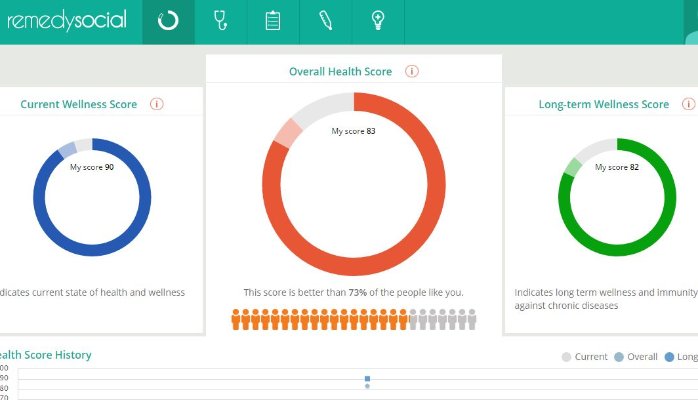

We at Remedy Social have been working for more than past 1.5 years on developing a health score that reflects an individuals health status in an accurate manner, shares Dr Purav Gandhi exclusively with Elets News Network (ENN)

Why are numbers important? When we have things that can be described qualitatively, why quantify stuff? However, we do require numbers because numbers make us precise, allow to measure things accurately and be more definitive in conveying information and decisions.
Why do we require indices or scores? When we can describe things in detail, why narrow down the findings to a single score or an index? However, whether it is sports or business, we do have scores or indices to summarise the nuances of a team performance into a single objective number, and based on that decide a winner.
At the end of a cricket game, one might argue the scoreline doesnt reflect the true nature of performance or competition in the game, but, at the end of the day despite all criticism a game will be meaningless if it were not for scores determining a winner.

 Health is arguably as nuanced and complex as a game of cricket. It has many aspects to it, multiple nuances, objective and subjective interpretations, and differs from an individual to individual. However, still to make meaning out of it eventually we do need a way to measure and quantify the same. We at Remedy Social have been working for more than past 1.5 years on developing a health score that reflects an individuals health status in an accurate manner. While the journey has been very long, interesting and full of learnings, I wanted to share some basic learnings, experiences and practical challenges that I have observed.
Health is arguably as nuanced and complex as a game of cricket. It has many aspects to it, multiple nuances, objective and subjective interpretations, and differs from an individual to individual. However, still to make meaning out of it eventually we do need a way to measure and quantify the same. We at Remedy Social have been working for more than past 1.5 years on developing a health score that reflects an individuals health status in an accurate manner. While the journey has been very long, interesting and full of learnings, I wanted to share some basic learnings, experiences and practical challenges that I have observed.
 The first question that one has to ask is what are the characteristics of an ideal health score or health index:
The first question that one has to ask is what are the characteristics of an ideal health score or health index:
- Measurable: Health score needs to help measure an individual or a groups state of health, progress or deterioration over time as more information is shared, and should enable measuring health impact of a particular intervention
- Actionable: Health score should be actionable in nature, i.e. should be able to capture nuances in an individuals health and based on that suggest appropriate interventions
- Comparable: Health score like any other index has limited meaning on its own. There should be appropriate scale, benchmarks and comparators to make meaning out the scores
Data is the key substrate for developing any health score or similar indices. In healthcare, data is an expensive asset, not always available in a uniform manner. These are the key sources of data that would play a role in determining an individuals health status:
- Demographic information (e.g. age, gender)
- Lifestyle information (e.g. diet, exercise, sleep)
- Personal information
- Medical history (current and past medical complaints/issues)
- Family medical history
- Fitness data (now more easily available and more accurate as compared to survey data)
- Laboratory test results
- Clinical / hospital data
- Medication / treatment data
- Genomic data, etc.
As you see the list of data elements mentioned above, like any other healthcare geek now you would start imagining the degree of complexity associated with calculating a health score. Based on experience so far, I have listed a few key challenges that we have observed so far:
- Data availability: Data is not always available, or typically in healthcare all data is not always available. There is limited availability of data and based on those data points we have to make sense around an individual or groups’ health status
- Data standards: Data is not always available in the same format. As they say, the challenge with healthcare data standards is that there are too many of them
- Data consistency: Data is not always available in a consistent manner, i.e. for some patients, we may get clinical data, for others lab data and for the rest of them we might lifestyle and fitness information
- Data interpretation: Data is sometimes conflicting, as in multiple data sources are available indicating the same thing. E.g., there are factors indicating risk of diabetes, blood sugar readings, and symptoms reflective of diabetes status and all of them might have conflicting results, creating challenges in which reading to take when and how much weightage to allocate to each source of data
- Interplay of various factors: Data is not always about individual elements, but sometimes an interplay of various readings and sources that come together and create meaningful insights
- Population bias: Data does not always mean the same thing for different people; normal ranges, cut-off and readings vary based on different demographic factors for a population and hence again create lack of uniformity in the system
- Need to capture nuances: Just one unique health-score does not always reflect all the nuances of an individuals health e.g., two people might have the same health score, but one of them might have more current health problems, while the other one might seem perfectly healthy but have more long-term risks.
With challenges come opportunities, and here also we see a definitive way forward in terms of solving the health score mystery:
- Start somewhere: The golden rule and conventional wisdom to solve any challenge are that one has to start somewhere at least develop a basic health-scoring engine, which can be improved over a period of time
- Low entry barrier: Data is scarce and people dont usually have time to share more information, so keep a low entry barrier where you can start an assessment with very limited information
- Progressive nature: However, we need to have a progressive framework that can keep ingesting more data from multiple sources and refine health scores as more information is available
- Adaptable: Develop a scoring framework that can adapt itself to various geographies, industries or any such factors that can impact health in a significant manner
- Multiple sub-indices: In an ideal state, develop sub-indices that can tease out nuances of the health score, e.g. at Remedy Social, we created a Current Health Score & Long-term Wellness Score in addition to an Overall Health Score
- Disease-specific components: Develop sub-indices or risk models that are able to generate insights and intervention suggestions for specific diseases, in order to make the scoring really actionable
- Link with actions/interventions: Use data and benchmarks to be able to understand specific cut-off points and link them to specific actions or interventions, to ensure that the health score has a high utility
About the Author
Dr Purav Gandhi is a physician and MBA with extensive experience in healthcare analytics and delivery space. Currently, he runs a healthcare analytics platform called as Remedy Social, focused on quantifying health & helping stakeholders make informed decisions regarding their health. Prior to Remedy Social, he had helped co-found ConvergeHEALTH by Deloitte, an analytics-based product business helping life sciences organisations leverage clinical data for personalising treatment and improving outcomes. He is very passionate about exploring data & analytics-driven innovation in the healthcare & life sciences sector.
Be a part of Elets Collaborative Initiatives. Join Us for Upcoming Events and explore business opportunities. Like us on Facebook , connect with us on LinkedIn and follow us on Twitter , Instagram.












